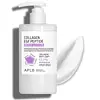What's inside
What's inside
 Key Ingredients
Key Ingredients

 Benefits
Benefits

 Concerns
Concerns

 Ingredients Side-by-side
Ingredients Side-by-side

Water
Skin ConditioningCentella Asiatica Leaf Water
Skin ConditioningGlycerin
HumectantCetyl Ethylhexanoate
EmollientCetearyl Alcohol
EmollientGlyceryl Stearate
EmollientPEG-100 Stearate
Sorbitan Stearate
Emulsifying1,2-Hexanediol
Skin ConditioningCyclopentasiloxane
EmollientSaccharide Hydrolysate
HumectantDimethicone
EmollientCyclohexasiloxane
EmollientStearic Acid
CleansingChlorphenesin
AntimicrobialCarbomer
Emulsion StabilisingGlyceryl Stearate Se
EmulsifyingCaprylyl Glycol
EmollientXanthan Gum
EmulsifyingPotassium Hydroxide
BufferingDisodium EDTA
Hydrolyzed Collagen
EmollientButylene Glycol
HumectantDipropylene Glycol
HumectantSqualane
EmollientAsiaticoside
AntioxidantMadecassic Acid
Skin ConditioningAsiatic Acid
Skin ConditioningSodium Hyaluronate
HumectantMelaleuca Alternifolia Leaf Extract
PerfumingHippophae Rhamnoides Fruit Extract
Skin ConditioningEthylhexylglycerin
Skin ConditioningBeta-Glucan
Skin ConditioningNelumbium Speciosum Flower Extract
Skin ConditioningArtemisia Annua Extract
MaskingOryza Sativa Extract
AbsorbentSaccharomyces Ferment
Skin ConditioningSolanum Melongena Fruit Extract
Skin ConditioningSh-Oligopeptide-1
Skin ConditioningWater, Centella Asiatica Leaf Water, Glycerin, Cetyl Ethylhexanoate, Cetearyl Alcohol, Glyceryl Stearate, PEG-100 Stearate, Sorbitan Stearate, 1,2-Hexanediol, Cyclopentasiloxane, Saccharide Hydrolysate, Dimethicone, Cyclohexasiloxane, Stearic Acid, Chlorphenesin, Carbomer, Glyceryl Stearate Se, Caprylyl Glycol, Xanthan Gum, Potassium Hydroxide, Disodium EDTA, Hydrolyzed Collagen, Butylene Glycol, Dipropylene Glycol, Squalane, Asiaticoside, Madecassic Acid, Asiatic Acid, Sodium Hyaluronate, Melaleuca Alternifolia Leaf Extract, Hippophae Rhamnoides Fruit Extract, Ethylhexylglycerin, Beta-Glucan, Nelumbium Speciosum Flower Extract, Artemisia Annua Extract, Oryza Sativa Extract, Saccharomyces Ferment, Solanum Melongena Fruit Extract, Sh-Oligopeptide-1
Water
Skin ConditioningDipropylene Glycol
HumectantParaffinum Liquidum
EmollientSodium Ascorbate
Antioxidant3-Glyceryl Ascorbate
AntioxidantGalactomyces Ferment Filtrate
HumectantHydrolyzed Sweet Almond Protein
Skin ConditioningHydrolyzed Rice Protein
Skin ConditioningHydrolyzed Soy Protein
HumectantPrunus Amygdalus Dulcis Oil
Skin ConditioningOryza Sativa Starch
AbsorbentLactobacillus/Soymilk Ferment Filtrate
Skin ConditioningRetinol
Skin ConditioningSteareth-13
EmulsifyingSorbitan Sesquioleate
EmulsifyingCarbomer
Emulsion StabilisingNiacinamide
SmoothingPhenoxyethanol
PreservativeParfum
MaskingPotassium Hydroxide
BufferingMethylparaben
PreservativeHydroxyethylcellulose
Emulsion StabilisingGlycerin
HumectantCaprylic/Capric Triglyceride
MaskingButylene Glycol
HumectantTocopherol
AntioxidantPEG-40 Hydrogenated Castor Oil
EmulsifyingWater, Dipropylene Glycol, Paraffinum Liquidum, Sodium Ascorbate, 3-Glyceryl Ascorbate, Galactomyces Ferment Filtrate, Hydrolyzed Sweet Almond Protein, Hydrolyzed Rice Protein, Hydrolyzed Soy Protein, Prunus Amygdalus Dulcis Oil, Oryza Sativa Starch, Lactobacillus/Soymilk Ferment Filtrate, Retinol, Steareth-13, Sorbitan Sesquioleate, Carbomer, Niacinamide, Phenoxyethanol, Parfum, Potassium Hydroxide, Methylparaben, Hydroxyethylcellulose, Glycerin, Caprylic/Capric Triglyceride, Butylene Glycol, Tocopherol, PEG-40 Hydrogenated Castor Oil
 Reviews
Reviews

Ingredients Explained
These ingredients are found in both products.
Ingredients higher up in an ingredient list are typically present in a larger amount.
Butylene Glycol (or BG) is used within cosmetic products for a few different reasons:
Overall, Butylene Glycol is a safe and well-rounded ingredient that works well with other ingredients.
Though this ingredient works well with most skin types, some people with sensitive skin may experience a reaction such as allergic rashes, closed comedones, or itchiness.
Learn more about Butylene GlycolCarbomer is a polymer of acrylic acid. Its main role is to create a gel consistency.
A high amount of carbomer can cause pilling or balling up of products. Don't worry, most products contain 1% or less of carbomer.
Dipropylene Glycol is a synthetically created humectant, stabilizer, and solvent.
This ingredient helps:
Dipropylene glycol is technically an alcohol, but it belongs to the glycol family (often considered part of the ‘good’ alcohols). This means it is hydrating and gentle on skin unlike drying solvent alcohols like denatured alcohol.
As a masking agent, Dipropylene Glycol can be used to cover the smell of other ingredients. However, it does not have a scent.
Studies show Dipropylene Glycol is considered safe to use in skincare.
Learn more about Dipropylene GlycolGlycerin is already naturally found in your skin. It helps moisturize and protect your skin.
A study from 2016 found glycerin to be more effective as a humectant than AHAs and hyaluronic acid.
As a humectant, it helps the skin stay hydrated by pulling moisture to your skin. The low molecular weight of glycerin allows it to pull moisture into the deeper layers of your skin.
Hydrated skin improves your skin barrier; Your skin barrier helps protect against irritants and bacteria.
Glycerin has also been found to have antimicrobial and antiviral properties. Due to these properties, glycerin is often used in wound and burn treatments.
In cosmetics, glycerin is usually derived from plants such as soybean or palm. However, it can also be sourced from animals, such as tallow or animal fat.
This ingredient is organic, colorless, odorless, and non-toxic.
Glycerin is the name for this ingredient in American English. British English uses Glycerol/Glycerine.
Learn more about GlycerinPotassium hydroxide is commonly known as caustic potash. It is used to fix the pH of a product or as a cleaning agent in soap. In cleansers, it is used for the saponification of oils.
Sapnification is the process of creating fatty acid metal salts from triglycerides and a strong base. During this process, Potassium Hydroxide is used up and is not present in the final product.
Using high concentrations of Potassium Hydroxide have shown to irritate the skin.
Learn more about Potassium HydroxideWater. It's the most common cosmetic ingredient of all. You'll usually see it at the top of ingredient lists, meaning that it makes up the largest part of the product.
So why is it so popular? Water most often acts as a solvent - this means that it helps dissolve other ingredients into the formulation.
You'll also recognize water as that liquid we all need to stay alive. If you see this, drink a glass of water. Stay hydrated!
Learn more about Water